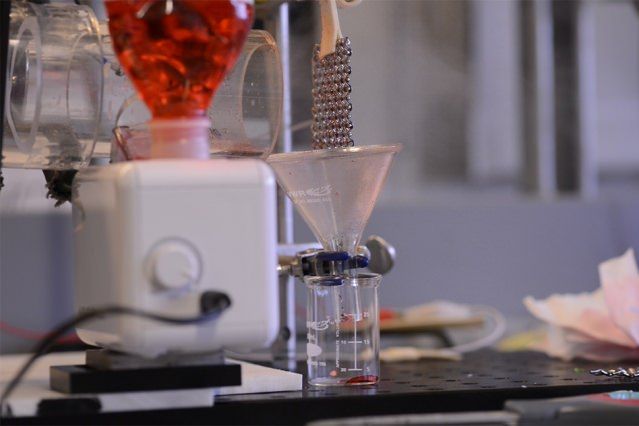New System Recovers Fresh Water From Power Plants
Published on by Water Network Research, Official research team of The Water Network in Technology
A new system devised by MIT engineers could provide a low-cost source of drinking water for parched cities around the world while also cutting power plant operating costs.
By David L. Chandler

The team’s lab setup was used to test the powerplant condenser system. The mesh is placed above the funnel at right to collect the water that condenses on the mesh. Courtesy of researchers, Source: MIT
About 39 percent of all the fresh water withdrawn from rivers, lakes, and reservoirs in the U.S. is earmarked for the cooling needs of electric power plants that use fossil fuels or nuclear power, and much of that water ends up floating away in clouds of vapor. But the new MIT system could potentially save a substantial fraction of that lost water — and could even become a significant source of clean, safe drinking water for coastal cities where seawater is used to cool local power plants.
The principle behind the new concept is deceptively simple: When air that’s rich in fog is zapped with a beam of electrically charged particles, known as ions, water droplets become electrically charged and thus can be drawn toward a mesh of wires, similar to a window screen, placed in their path. The droplets then collect on that mesh, drain down into a collecting pan, and can be reused in the power plant or sent to a city’s water supply system.
The system, which is the basis for a startup company called Infinite Cooling that last month won MIT’s $100K Entrepreneurship Competition, is described in a paper published today in the journal Science Advances, co-authored by Maher Damak PhD ’18 and associate professor of mechanical engineering Kripa Varanasi. Damak and Varanasi are among the co-founders of the startup.
Varanasi’s vision was to develop highly efficient water recovery systems by capturing water droplets from both natural fog and plumes of industrial cooling towers. The project began as part of Damak’s doctoral thesis, which aimed to improve the efficiency of fog-harvesting systems that are used in many water-scarce coastal regions as a source of potable water. Those systems, which generally consist of some kind of plastic or metal mesh hung vertically in the path of fogbanks that regularly roll in from the sea, are extremely inefficient, capturing only about 1 to 3 percent of the water droplets that pass through them. Varanasi and Damak wondered if there was a way to make the mesh catch more of the droplets — and found a very simple and effective way of doing so.
The reason for the inefficiency of existing systems became apparent in the team’s detailed lab experiments: The problem is in the aerodynamics of the system. As a stream of air passes an obstacle, such as the wires in these mesh fog-catching screens, the airflow naturally deviates around the obstacle, much as air flowing around an airplane wing separates into streams that pass above and below the wing structure. These deviating airstreams carry droplets that were heading toward the wire off to the side, unless they were headed bang-on toward the wire’s center.
The result is that the fraction of droplets captured is far lower than the fraction of the collection area occupied by the wires, because droplets are being swept aside from wires that lie in front of them. Just making the wires bigger or the spaces in the mesh smaller tends to be counterproductive because it hampers the overall airflow, resulting in a net decrease in collection.
But when the incoming fog gets zapped first with an ion beam, the opposite effect happens. Not only do all of the droplets that are in the path of the wires land on them, even droplets that were aiming for the holes in the mesh get pulled toward the wires. This system can thus capture a much larger fraction of the droplets passing through. As such, it could dramatically improve the efficiency of fog-catching systems, and at a surprisingly low cost. The equipment is simple, and the amount of power required is minimal.
Next, the team focused on capturing water from the plumes of power plant cooling towers. There, the stream of water vapor is much more concentrated than any naturally occurring fog, and that makes the system even more efficient. And since capturing evaporated water is in itself a distillation process, the water captured is pure, even if the cooling water is salty or contaminated. At this point, Karim Khalil, another graduate student from Varanasi’s lab joined the team.
“It’s distilled water, which is of higher quality, that’s now just wasted,” says Varanasi. “That’s what we’re trying to capture.” The water could be piped to a city’s drinking water system, or used in processes that require pure water, such as in a power plant’s boilers, as opposed to being used in its cooling system where water quality doesn’t matter much.
Read full article: MIT
Attached link
http://www.youtube.com/embed/3u6ZNSaRhfgMedia
Taxonomy
- Treatment
- Drinking Water Treatment
- Resource Management
- Technology
- Cooling Systems
- Water Resources
- Drinking Water Managment
- Drinking Water
- water treatment
- Cooling Systems
- Power Plants